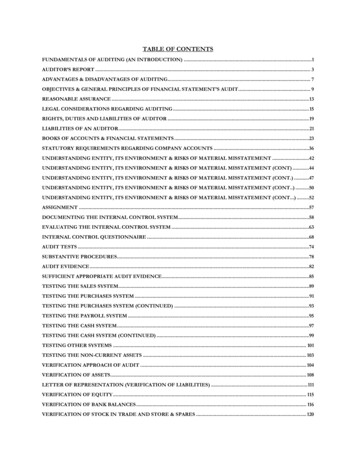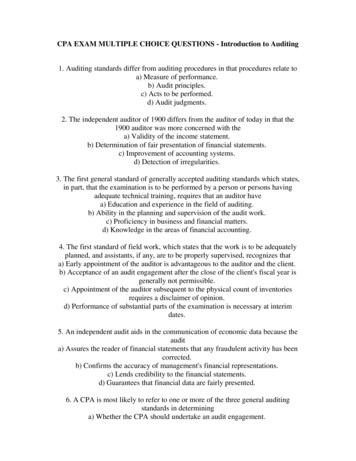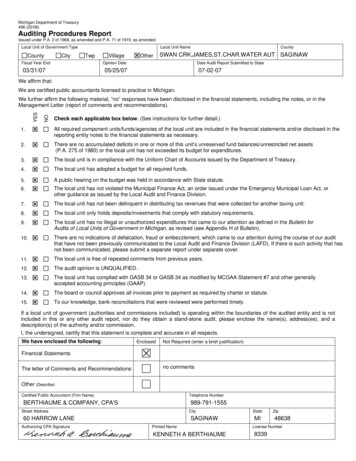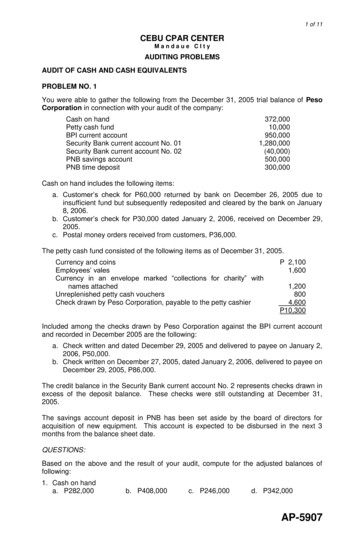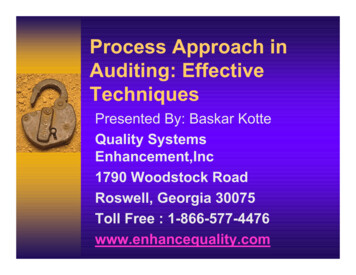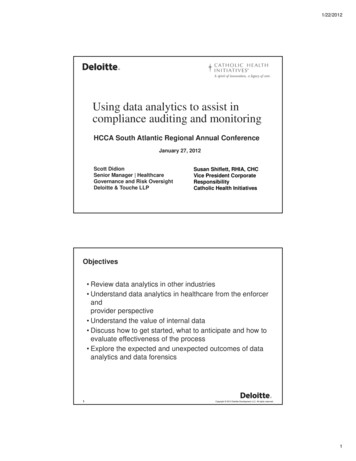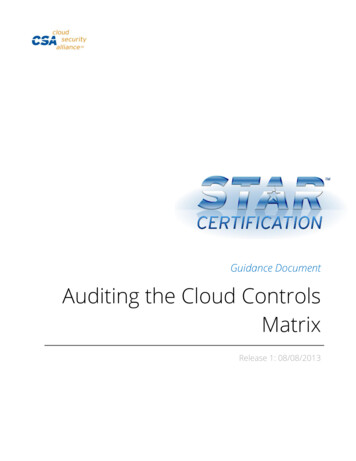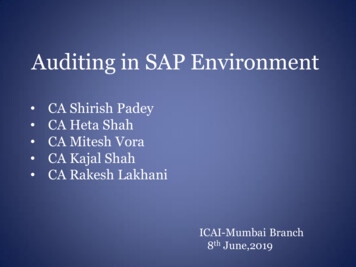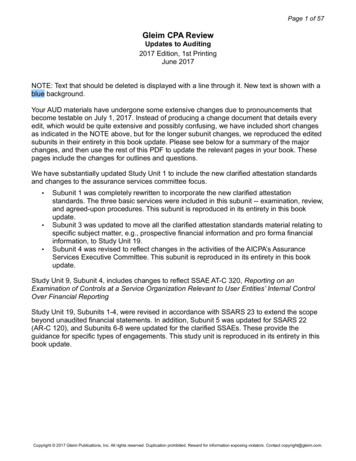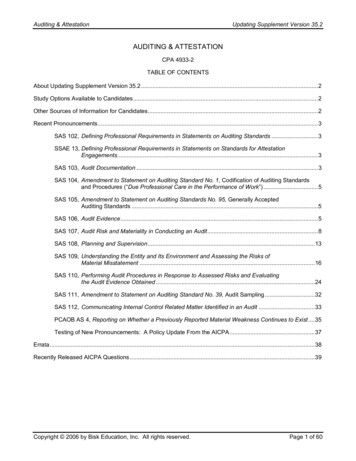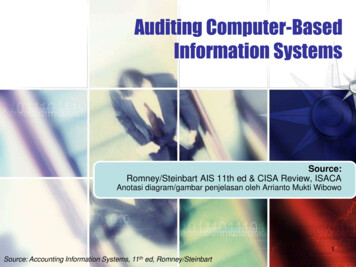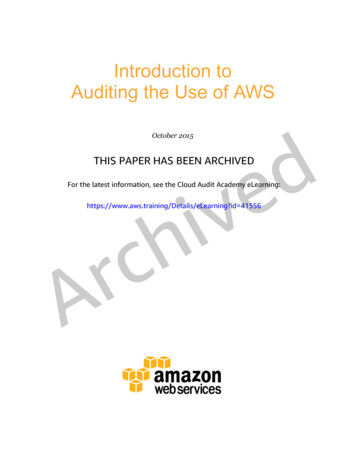
Transcription
Introduction toAuditing the Use of AWSdeOctober 2015THIS PAPER HAS BEEN ARCHIVEDvihFor the latest information, see the Cloud Audit Academy ng?id 41556crA
Amazon Web Services – Introduction to Auditing the Use of AWSOctober 2015 2015, Amazon Web Services, Inc. or its affiliates. All rights reserved.NoticesThis document is provided for informational purposes only. It represents AWS’scurrent product offerings and practices as of the date of issue of this document,which are subject to change without notice. Customers are responsible formaking their own independent assessment of the information in this documentand any use of AWS’s products or services, each of which is provided “as is”without warranty of any kind, whether express or implied. This document doesnot create any warranties, representations, contractual commitments, conditionsor assurances from AWS, its affiliates, suppliers or licensors. The responsibilitiesand liabilities of AWS to its customers are controlled by AWS agreements, andthis document is not part of, nor does it modify, any agreement between AWSand its customers.vihdecrAPage 2 of 28
Amazon Web Services – Introduction to Auditing the Use of AWSOctober 2015ContentsAbstract4Introduction5Approaches for using AWS Audit Guides6Examiners6deAWS Provided Evidence6Auditing Use of AWS ConceptsIdentifying assets in AWSvihAWS Account Identifiers1.Governance2.Network Configuration and ManagementcrA9910143.Asset Configuration and Management4.Logical Access Control5.Data Encryption6.Security Logging and Monitoring207.Security Incident Response218. Disaster Recovery9.Page 3 of 288Inherited Controls1517192223Appendix A: References and Further Reading25Appendix B: Glossary of Terms26Appendix C: API Calls27
Amazon Web Services – Introduction to Auditing the Use of AWSOctober 2015AbstractSecurity at AWS is job zero. All AWS customers benefit from a data center andnetwork architecture built to satisfy the needs of the most security-sensitiveorganizations. In order to satisfy these needs, AWS compliance enablescustomers to understand the robust controls in place at AWS to maintain securityand data protection in the cloud.deAs systems are built on top of AWS cloud infrastructure, complianceresponsibilities will be shared. By tying together governance-focused, auditfriendly service features with applicable compliance or audit standards, AWSCompliance enablers build on traditional programs, helping customers toestablish and operate in an AWS security control environmentvihAWS manages the underlying infrastructure, and you manage the security ofanything you deploy in AWS. AWS as a modern platform allows you to formalizethe design of security, as well as audit controls, through reliable, automated andverifiable technical and operational processes built into every AWS customeraccount. The cloud simplifies system use for administrators and those runningIT, and makes your AWS environment much simpler to audit sample testing, asAWS can shift audits towards a 100% verification verses traditional sampletesting.crAAdditionally, AWS’ purpose-built tools can be tailored to customer requirementsand scaling and audit objectives, in addition to supporting real-time verificationand reporting through the use of internal tools such as AWS CloudTrail, Configand CloudWatch. These tools are built to help you maximize the protection ofyour services, data and applications. This means AWS customers can spend lesstime on routine security and audit tasks, and are able to focus more on proactivemeasures which can continue to enhance security and audit capabilities of theAWS customer environment.Page 4 of 28
Amazon Web Services – Introduction to Auditing the Use of AWSOctober 2015IntroductionAs more and more customers deploy workloads into the cloud, auditorsincreasingly need not only to understand how the cloud works, but additionallyhow to leverage the power of cloud computing to their advantage when conductingaudits. The AWS cloud enables auditors to shift from percentage-based sampletesting toward a comprehensive real-time audit view, which enables 100%auditability of the customer environment, as well as real-time risk management.deThe AWS management console, along with the Command Line Interface (CLI),can produce powerful results for auditors across multiple regulatory, standardsand industry authorities. This is due to AWS supporting a multitude of securityconfigurations to establish security, compliance by design, and real-time auditcapabilities through the use of: vihAutomation - Scriptable infrastructure (e.g. Infrastructure as Code)allows you to create repeatable, reliable and secure deployment systems byleveraging programmable (API-driven) deployments of services.crAPage 5 of 28 Scriptable Architectures – “Golden” environments and AmazonMachine Images (AMIs) can be deployed for reliable and auditableservices, and they can be constrained to ensure real-time riskmanagement. Distribution - Capabilities provided by AWS CloudFormation givesystems administrators an easy way to create a collection of related AWSresources and provision them in an orderly and predictable fashion. Verifiable- Using AWS CloudTrail, Amazon CloudWatch, AWSOpsWorks and AWS CloudHSM enables evidence gathering capability.
Amazon Web Services – Introduction to Auditing the Use of AWSOctober 2015Approaches for using AWS Audit GuidesExaminersWhen assessing organizations that use AWS services, it is critical to understandthe “Shared Responsibility” model between AWS and the customer. The auditguide organizes the requirements into common security program controls andcontrol areas. Each control references the applicable audit requirements.deIn general, AWS services should be treated similarly to on-premise infrastructureservices that have been traditionally used by customers for operating services andapplications. Policies and processes that apply to devices and servers should alsoapply when those functions are supplied by AWS. Controls pertaining solely topolicy or procedure are generally entirely the responsibility of the customer.Similarly, AWS management, either via the AWS Console or Command Line API,should be treated like other privileged administrator access. See the appendixand referenced points for more information.vihcrAAWS Provided EvidenceAmazon Web Services Cloud Compliance enables customers to understand therobust controls in place at AWS to maintain security and data protection in thecloud. As systems are built on top of AWS cloud infrastructure, complianceresponsibilities will be shared. Each certification means that an auditor hasverified that specific security controls are in place and operating as intended. Youcan view the applicable compliance reports by contacting your AWS accountrepresentative. For more information about the security regulations andstandards with which AWS complies visit the AWS Compliance webpage. To helpyou meet specific government, industry, and company security standards andregulations, AWS provides certification reports that describe how the AWS Cloudinfrastructure meets the requirements of an extensive list of global securitystandards, including: ISO 27001, SOC, the PCI Data Security Standard,FedRAMP, the Australian Signals Directorate (ASD) Information SecurityManual, and the Singapore Multi-Tier Cloud Security Standard (MTCS SS 584).Page 6 of 28
Amazon Web Services – Introduction to Auditing the Use of AWSOctober 2015For more information about the security regulations and standards with whichAWS complies, see the AWS Compliance webpage.vihdecrAPage 7 of 28
Auditing Use of AWS ConceptsThe following concepts should be considered during a security audit of anorganization’s systems and data on AWS: Security measures that the cloud service provider (AWS) implements andoperates – "security of the cloud" Security measures that the customer implements and operates, related tothe security of customer content and applications that make use of AWSservices – "security in the cloud"deWhile AWS manages security of the cloud, security in the cloud is theresponsibility of the customer. Customers retain control of what security theychoose to implement to protect their own content, platform, applications,systems and networks, no differently than they would for applications in an onsite datacenter.vihcrAAdditional detail can be found at the AWS Security Center, at AWS Compliance,and in the publically available AWS whitepapers found at: AWS Whitepapers
Identifying assets in AWSA customer’s AWS assets can be instances, data stores, applications, and thedata itself. Auditing the use of AWS generally starts with asset identification.Assets on a public cloud infrastructure are not categorically different than inhouse environments, and in some situations can be less complex to inventorybecause AWS provides visibility into the assets under management.AWS Account IdentifiersdeAWS assigns two unique IDs to each AWS account: an AWS account ID and acanonical user ID. The AWS account ID is a 12-digit number, such as123456789012, that you use to construct Amazon Resource Names (ARNs).When you refer to resources, like an IAM user or an Amazon Glacier vault, theaccount ID distinguishes your resources from resources in other AWS accounts.vihAmazon Resource Names (ARNs) and AWS Service NamespacesAmazon Resource Names (ARNs) uniquely identify AWS resources. We requirean ARN when you need to specify a resource unambiguously across all of AWS,such as in IAM policies, Amazon Relational Database Service (Amazon RDS)tags, and API calls.crAARN Format example:In addition to Account Identifiers, Amazon Resource Names (ARNs) and AWSService Namespaces, each AWS service creates a unique service identifier (e.g.Amazon Elastic Compute Cloud (Amazon EC2) instance ID: i-3d68c5cb orAmazon Elastic Block Store (Amazon EBS) Volume ID vol-ecd8c122) which canbe used to create an environmental asset inventory and used within work papersfor scope of audit and inventory.Each certification means that an auditor has verified that specific securitycontrols are in place and operating as intended.
Amazon Web Services – OCIE Cybersecurity Audit GuideSeptember 20151. GovernanceDefinition: Governance provides assurance that customer direction and intentare reflected in the security posture of the customer. This is achieved by utilizinga structured approach to implementing an information security program. For thepurposes of this audit plan, it means understanding which AWS services havebeen purchased, what kinds of systems and information you plan to use with theAWS service, and what policies, procedures, and plans apply to these services.deMajor audit focus: Understand what AWS services and resources are beingused and ensure your security or risk management program has taken intoaccount the use of the public cloud environment.Audit approach: As part of this audit, determine who within your organizationis an AWS account and resource owner, as well as the AWS services andresources they are using. Verify policies, plans, and procedures include cloudconcepts, and that cloud is included in the scope of the customer’s audit program.Governance ChecklistvihcrAChecklist ItemUnderstand use of AWS within your organization. Approaches might include: Polling or interviewing your IT and development teams. Performing network scans, or a more in-depth penetration test. Review expense reports and/or Purchase Orders (PO’s) payments related toAmazon.com or AWS to understand what services are being used. Credit cardcharges appear as “AMAZON WEB SERVICES AWS.AMAZON.CO WA” orsimilar.Note: Some individuals within your organization may have signed up for an AWS accountunder their personal accounts, as such, consider asking if this is the case when polling orinterviewing your IT and development teams.Identify assets. Each AWS account has a contact email address associated with it andcan be used to identify account owners. It is important to understand that this e-mailaddress may be from a public e-mail service provider, depending on what the userspecified when registering. Page 10 of 28A formal meeting can be conducted with each AWS account or asset owner to
Amazon Web Services – Introduction to Auditing the Use of AWSOctober 2015Checklist Itemunderstand what is being deployed on AWS, how it is managed, and how it has beenintegrated with your organization’s security policies, procedures, and standards.Note: The AWS Account owner may be someone in the finance or procurementdepartment, but the individual who implements the organization’s use of the AWSresources may reside in the IT department. You may need to interview both.deDefine your AWS boundaries for review. The review should have a defined scope.Understand your organization’s core business processes and their alignment with IT, inits non-cloud form as well as current or future cloud implementations.vih Obtain a description of the AWS services being used and/or being considered for use. After identifying the types of AWS services in use or under consideration, determinethe services and business solutions to be included in the review. Obtain and review any previous audit reports with remediation plans.crA Identify open issues in previous audit reports and assess updates to the documentswith respect to these issues.Assess policies. Assess and review your organization’s security, privacy, and dataclassification policies to determine which policies apply to the AWS service environment. Verify if a formal policy and/or process exists around the acquisition of AWS servicesto determine how purchase of AWS services is authorized. Verify if your organization’s change management processes and policies includeconsideration of AWS servicesIdentify risks. Determine whether a risk assessment for the applicable assets has beenperformed.Review risks. Obtain a copy of any risk assessment reports and determine if they reflectthe current environment and accurately describe the residual risk environment.Review risks documentation. After each element of your review, review risktreatment plans and timelines/milestones against your risk management policies andPage 11 of 28
Amazon Web Services – Introduction to Auditing the Use of AWSOctober 2015Checklist Itemprocedures.Documentation and Inventory. Verify your AWS network is fully documented andall AWS critical systems are included in their inventory documentation, with limitedaccess to this documentation. deReview AWS Config for AWS resource inventory and configuration history ofresources (Example API Call, 1). Ensure that resources are appropriately tagged and associated with application data. Review application architecture to identify data flows, planned connectivity betweenvihapplication components and resources that contain data. Review all connectivity between your network and the AWS Platform by reviewingthe following: VPN connections where the customers on-premise Public IPs are mapped tocrAcustomer gateways in any VPCs owned by the Customer.(Example API Call, 2 & 3). Direct Connect Private Connections, which may bemapped to 1 or more VPCs owned by the customer. (Example API Call, 4)Evaluate risks. Evaluate the significance of the AWS-deployed data to theorganization’s overall risk profile and risk tolerance. Ensure that these AWS assets areintegrated into the organization’s formal risk assessment program. AWS assets should be identified and have protection objectives associated with them,depending on their risk profiles.Incorporate use of AWS into risk assessment. Conduct and/or incorporate AWSservice elements into your organizational risk assessment processes. Key risks couldinclude: Identify the business risk associated with your use of AWS and identify businessowners and key stakeholders. Verify that the business risks are aligned, rated, or classified within your use of AWSservices and your organizational security criteria for protecting confidentiality,Page 12 of 28
Amazon Web Services – Introduction to Auditing the Use of AWSOctober 2015Checklist Itemintegrity, and availability. Review previous audits related to AWS services (SOC, PCI, NIST 800-53 relatedaudits, etc.). Determine if the risks identified previously have been appropriately addressed.Evaluate the overall risk factor for performing your AWS review.Based on the risk assessment, identify changes to your audit scope.Discuss the risks with IT management, and adjust the risk assessment.deIT Security Program and Policy. Verify that the customer includes AWS services inits security policies and procedures, including AWS account level best practices ashighlighted within the AWS service Trusted Advisor which provides best practice andguidance across 4 topics – Security, Cost, Performance and Fault Tolerance.vih Review your information security policies and ensure that it includes AWS services. Confirm you have has assigned an employee(s) as authority for the use and securityof AWS services and there are defined roles for those noted key roles, including aChief Information Security Officer.crANote: any published cybersecurity risk management process standards you have used tomodel information security architecture and processes. Ensure you maintain documentation to support the audits conducted for AWSservices, including its review of AWS third-party certifications. Verify internal training records include AWS security, such as Amazon IAM usage,Amazon EC2 Security Groups, and remote access to Amazon EC2 instances. Confirm a cybersecurity response policy and training for AWS services ismaintained.Note: any insurance specifically related to the customers use of AWS services and anyclaims related to losses and expenses attributed to cybersecurity events as a result.Service Provider Oversight. Verify the contract with AWS includes a requirement toimplement and maintain privacy and security safeguards for cybersecurity requirements.Page 13 of 28
Amazon Web Services – Introduction to Auditing the Use of AWSOctober 20152. Network Configuration and ManagementDefinition: Network management in AWS is very similar to networkmanagement on-premises, except that network components such as firewalls androuters are virtual. Customers must ensure network architecture follows thesecurity requirements of their organization, including the use of DMZs toseparate public and private (untrusted and trusted) resources, the segregation ofresources using subnets and routing tables, the secure configuration of DNS,whether additional transmission protection is needed in the form of a VPN, andwhether to limit inbound and outbound traffic. Customers who must performmonitoring of their network can do so using host-based intrusion detection andmonitoring systems.devihMajor audit focus: Missing or inappropriately configured security controlsrelated to external access/network security that could result in a securityexposure.Audit approach: Understand the network architecture of the customer’s AWSresources, and how the resources are configured to allow external access from thepublic Internet and the customer’s private networks. Note: AWS Trusted Advisorcan be leveraged to validate and verify AWS configurations settings.crANetwork Configuration and Management ChecklistChecklist ItemNetwork Controls. Identify how network segmentation is applied within the AWSenvironment.Page 14 of 28 Review AWS Security Group implementation, AWS Direct Connect and AmazonVPN configuration for proper implementation of network segmentation and ACLand firewall setting or AWS services (Example API Call, 5 - 8). Verify you have a procedure for granting remote, Internet or VPN access toemployees for AWS Console access and remote access to Amazon EC2 networks andsystems. Review the following to maintain an environment for testing and development ofsoftware and applications that is separate from its business environment
Audit approach: As part of this audit, determine who within your organization is an AWS account and resource owner, as well as the AWS services and resources they are using. Verify policies, plans, and procedures include cloud concepts, and that cloud is included in the scope of the customer’s audit program. Governance

